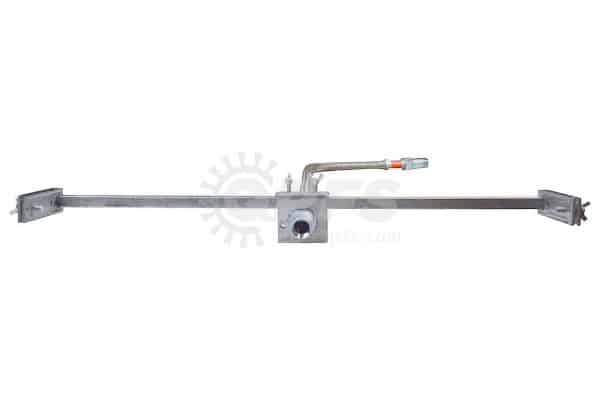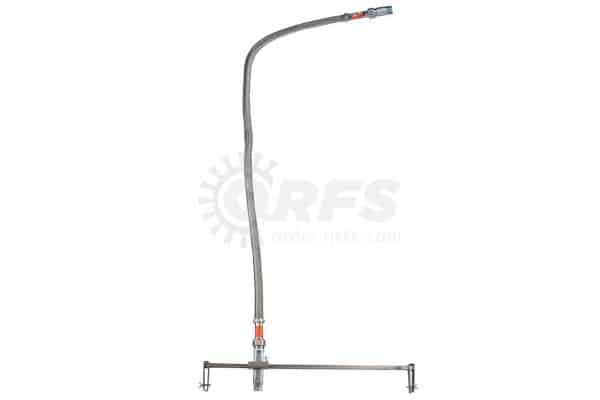NFPA 13 offers guidelines for easy flex sprinkler drop installations
Fire sprinkler flex drops solve a significant problem in the sprinkler industry. They prevent sprinkler misalignments in buildings at risk for ceiling movement, such as during seismic events or normal shifting of suspended ceilings.
When ceiling movement opens gaps around sprinklers, heat can pool in above-ceiling spaces instead of near sprinkler heads, causing sprinklers to activate dangerously late. Movement can also lead to obstructions between the ceiling’s new position and fixed-in-place sprinklers. Since fire sprinkler flex drops shift with ceilings, they enable heads to stay in the proper place and function normally during a fire.
Proper installation is essential to ensuring flexible sprinkler drops perform as expected, however. In the first installment of our two-part series on flexible sprinkler drops, we helped contractors make informed decisions about the right product to purchase for their installations.
In this installment, we review the National Fire Protection Association (NFPA) requirements for easy flex sprinkler drop installations.
In the market for flexible sprinkler drops? Browse our selection of FlexHead and SprinkFLEX flexible sprinkler head drops.
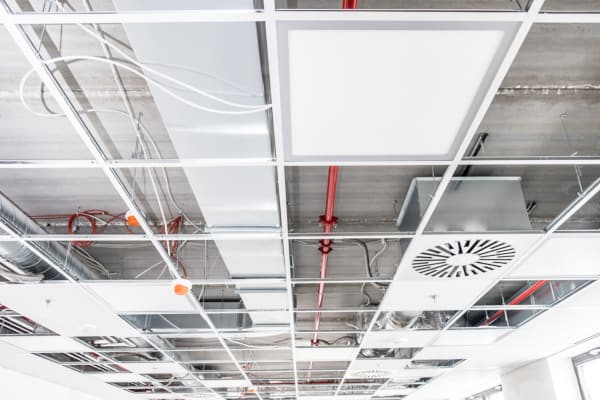
Fire sprinkler flex drops solve installation issues associated with suspended ceilings
Flexible metal hose assemblies have surged in popularity in recent years. Not only do they offer comparable material costs to traditional sprinkler armovers, but they install faster, solve many of the installation issues associated with suspended ceilings, and help protect sprinkler systems against earthquakes.
Many traditional sprinkler installations connect heads to their water supply through sprinkler armovers, a rigid piping arrangement also known as a return bend. Armovers use a tee and a series of elbows and stiff pipes to properly position sprinkler heads.
Suspended ceilings—also known as dropped or false ceilings—make armover installations even more complicated, forcing contractors to weave the series of pipes and fittings through panels. A suspended ceiling is a second ceiling hung below the main structural ceiling. It’s a common, cost-effective way of concealing necessary infrastructure in a building.
Fire sprinkler flex drop assemblies solve this problem by using flexible tubes to connect sprinkler heads and the rigid branch lines that supply water directly to sprinklers in the simplest manner possible. And unlike stiff pipes, these flexible tubes move along with suspended ceilings or seismic events.
Flexible drops are common in large-scale fire sprinkler installations in malls, airports, and other sizable buildings. Some models are even tailored to the special ceilings used in semiconductor manufacturing or research laboratories.
To learn more about the advantages of flexible sprinkler drops, read part one in our series.
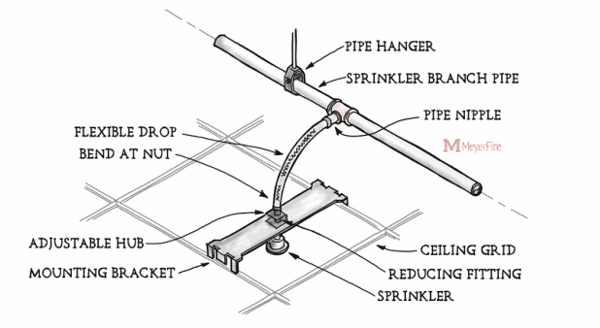
Fire sprinkler flex drops offer faster installations for a comparable price
In certain instances—such as dry sprinkler systems or systems supplied by ponds—fire codes may require armover assemblies to prevent an accumulation of water, dirt, or moisture. Sprinkler armovers resist sediment and moisture build-up. They also make it possible for installers to precisely place sprinkler heads in specific set-ups.
But sometimes, standard sprinkler armovers can drive installation costs in the wrong direction. A single return bend can consist of seven distinct pieces, some of which will need to be cut and joined. That makes putting them in a labor-intensive process.
Fire sprinkler flex drops allow installers to replace these involved piping arrangements with a single, simple device. Standard sizes range from 2′ (24″) to 6′ (72″), enabling the flexible tubes to stretch from branch lines to drop ceilings easily. Positioning brackets can then be used to place the head in a precise location with considerably less effort than an armover installation.
While flexible tube assemblies tend to carry a higher material cost than sprinkler armovers, their faster installation can significantly reduce labor costs—meaning quicker projects for the same price. Some fire sprinkler flex drops can also connect to sprinkler systems using grooved couplings, a known time-saver in other piping applications.
Sprinkler installations are often conducted in the later stages of construction when scheduling and deadline pressures are greatest. Sprinkler drops are typically installed before the ceiling grid is put in place, forcing the installer to return to complete panel cuts, as well as putting in the actual sprinkler heads and adjusting them. At the same time, other tasks are delayed until sprinkler work is finished.
Since flexible drops install faster and make it easy to modulate sprinkler height, they introduce greater flexibility and speed into construction schedules. They can also be secured out of the way after the initial connection to the supply line until the final installation begins. Not only does that make the work environment safer for other trades because they don’t have to work around hanging pipe, but there’s far less possibility of workers bumping into sprinkler pipe and no chance to disrupt any armover joints.
PM Engineer asserts that contractors can install at least four fire sprinkler flex drops in the time it takes to install a single sprinkler armover. Anvil International, the manufacturer of the FlexDrop and SprinkFLEX brand drops, estimates that these time savings increase even more when flexible drops are part of a retrofit of an existing building—enabling projects to progress six or seven times faster.
Watch this video to see the difference between fire sprinkler flex drop vs. rigid armover installations:
Fire sprinkler flex drops: What does NFPA require?
NFPA 13: Standard for the Installation of Sprinkler Systems does not mandate the use of flexible fire sprinkler drops, but it does offer a handful of provisions for installers that opt to use them. It addresses these products in 17.4.1.3.3, a subsection on the installation of pipe hangers dubbed “flexible sprinkler hose fittings.”
NFPA 13 requires fire sprinkler flex drops to be tested and listed by a third-party certification agency like UL or FM. In part one of our series, we discussed how the listings evaluate a hose’s flexibility. But these safety and function ratings also examine other critical factors, including confirming corrosion resistance, pressure tolerance, and strength in the face of vibration.
From the 2019 edition of NFPA 13
17.4.1.3.3.1 Listed flexible sprinkler hose fittings and their anchoring components intended for use in installations connecting the sprinkler system piping to sprinklers shall be installed in accordance with the requirements of the listing, including any installation instructions.
To guard against unwanted relocation after installation, NFPA 13 requires labels on brackets or other anchoring components where movement is likely, such as suspended ceilings.
A.17.4.1.3.3.4 recommends language that warns, “relocation of this device should be only be performed by qualified and/or licensed individuals that are aware of the original system design criteria, hydraulic criteria, sprinkler listing parameters, and knowledge of the state and local codes including NFPA 13 installation standards.” Relocating this device without this knowledge, the standard adds, “could adversely affect the performance of this fire protection and life safety system.”
From the 2019 edition of NFPA 13
17.4.1.3.3.4* Where flexible sprinkler hose fittings are used to connect sprinklers to branch lines in suspended ceilings, a label limiting relocation of the sprinkler shall be provided on the anchoring component.
The NFPA 13 Handbook offers other best practices for ensuring sprinklers remain in their designated spots, including choosing a fire sprinkler flex drop with as little excess hose as possible.
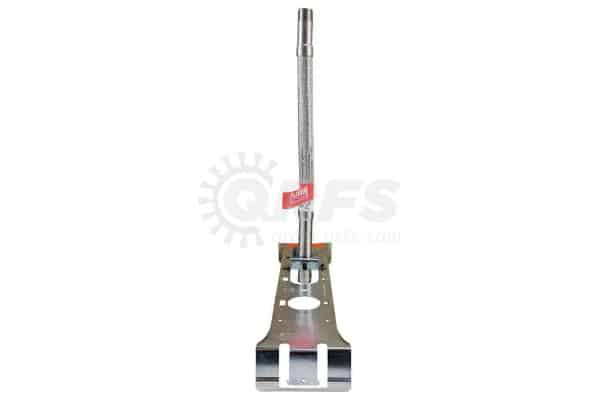
NFPA 13 puts parameters on pipe hangers and ceilings used with fire sprinkler flex drops
NFPA 13’s section on flexible sprinkler hose fittings also sets rules for pipe hangers and ceilings. Its goal: to ensure drops have the support they need to stay in place.
From the 2019 edition of NFPA 13
17.4.1.3.3.2 When installed and supported by suspended ceilings, the ceiling shall meet ASTM C635/C635M, Standard Specification for the Manufacture, Performance, and Testing of Metal Suspension Systems for Acoustical Tile and Lay-In Panel Ceilings, and shall be installed in accordance with ASTM C636/C636M, Standard Practice for Installation of Metal Ceiling Suspension Systems for Acoustical Tile and Lay-In Panels.
17.4.1.3.3.3* Where flexible sprinkler hose fittings exceed 6 ft (1.8 m) in length and are supported by a suspended ceiling in accordance with 17.4.1.3.3.2, a hanger(s) attached to the structure shall be required to ensure that the maximum unsupported length does not exceed 6 ft (1.8 m).
Not all ASTM C635/C635M suspension systems are created equally. The standard establishes rules for different types of ceilings that depend on the loads they support. Guidelines pertain to metal thickness, squareness, and length.
By mandating that suspended ceilings follow ASTM requirements, NFPA 13 ensures that they are manufactured and installed in a way that can support any attached drops. Section 17.4.1.3.3.3 puts a limit on the length—and, thus indirectly, the weight—of the supported hose.
In the supporting annex, A.17.4.1.3.3.3 explains that the technical committee’s evaluation of flexible sprinkler hose fittings for suspended ceilings is based on the understanding that the maximum load shed to the ceiling is roughly 6 lbs. (2.7 kg). Data studied by the committee shows that a suspended ceiling meeting the requirements of …
- ASTM C635: Standard Specification for the Manufacture, Performance, and Testing of Metal Suspension Systems of Acoustical Tile and Lay-In Performance Ceilings
… and installed in accordance with:
- ASTM C636: Standard Practice for Installation of Metal Ceiling Suspension Systems for Acoustical Tile and Lay-In Panels
… can support that load.
NFPA guidelines help ensure fire sprinkler flex drops keep sprinkler heads in the proper place
Fire sprinkler flex drops allow contractors to perform faster work at roughly the same price. But proper installation is key to ensuring sprinklers function as expected during a fire. With rules for appropriate listings, labels, and support, NFPA 13 installation requirements ensure that flexible hose assemblies keep sprinklers from shifting out of place if ceilings settle or move.
QRFS carries two lines of flexible fire sprinkler drops from Anvil International: FlexHead and SprinkFLEX. Both brand-name assemblies feature braided stainless-steel hose and approvals from UL and FM.
Our supply of Flexhead and SprinkFLEX drops are designed to fit standard fire sprinklers sizes in a variety of lengths, including:
- FlexHead assemblies in 24″, 36″, and 48″ lengths for 3/4″ sprinklers
- SprinkFLEX assemblies in 28″, 40″, 48″, and 71″ lengths for 1/2″ heads
- 59″ SprinkFLEX assemblies for both 1/2″ and 3/4″ fire sprinklers
Both brands feature stable brackets that allow heads to install before placing the bracket in the ceiling. Our SprinkFLEX models feature a fully adjustable bracket that gives installers maximum flexibility in sprinkler head placement. FlexHead models ship standard with a multi-port bracket that allows installers to quickly position the head in the center or at either quarter of the bracket’s width.
Compare and shop our selection of FlexHead and SprinkFLEX flexible sprinkler head drops by clicking here.
Questions about flexible fire sprinkler drops? Call us at +1 (888) 361-6662 or email support@qrfs.com.
This blog was originally posted at blog.qrfs.com. Check us out at Facebook.com/QuickResponseFireSupply or on Twitter @QuickResponseFS.


